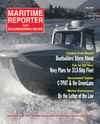
Page 44: of Maritime Reporter Magazine (May 2006)
The Marine Enviroment
Read this page in Pdf, Flash or Html5 edition of May 2006 Maritime Reporter Magazine
OSG Installs Bilge Water
Polisher
Wave International said that Overseas
Shipholding Group, Inc. (OSG) fitted its fleet with a filter system that polishes the bilge water prior to discharge. OSG owns and operates 89 vessels totaling 11,438,837 dwt.
The Wavestream system is an IMO- approved bilge water system that acts as a final polisher, designed to effec- tively remove any final traces of oil residue that are left after bilge water has passed through the ves- sel's oily water separator equip- ment. The
Wavestream oily water separator polish- ing system is a bilge water filter system designed to remove any final oils and emulsions from bilge water prior to dis- charge. With the new generation of
MEPC.107(49) oil in water monitors now capable of recognizing oil emul- sions as well as dispersed oil, the latest
Wavestream technology compliments them by reducing the number of inter- ruptions during bilge water discharge operations. "OSG sets very high environmental standards during all bilge pumping oper- ations and Wave International's new series of Wavestream polishing systems enable the company to exceed the IMO standards," said Paul Gullett, Wave
International's Managing Director.
Circle 4 on Reader Service Card
Automated Control Saves
Money
Nalfleet released data from an onboard trial of the NalTrak 3200 automated dos- ing and control for engine cooling and boiler systems. The results are from the
MV Susana of Reederei Blue Star
GmbH, which sails now as Maersk
Nolanville. A NalTrak system was installed in this 2,550-TEU container- ship in 2005.
Harald Krull, Reederei Blue Star's
Hamburg-based Technical Manager, wanted to reduce some of the heavy demands on crew time, but ensure the correctly prescribed amount of treat- ment chemicals were used. "I felt that automated dosing, rather than manual dosing, would protect the boiler and engine right from the start, and avoid downtime and serious problems in the future."
The typical cost for renewing furnace tubes in a container vessel boiler is approximately $36,000, not counting time out of service and lost revenue.
Susana's dynamic steam boiler appli- cation showed consistent control of dis- solved oxygen in feedwater, return con- densate pH, and boiler and engine cool- ing system conductivity - all critical to the protection and overall operation of the boiler and engine.
All the key streams were monitored and recorded in real time. Data was ana- lyzed using Nalco Vantage software, and the system is operated by using a touch screen that navigates a series of pages representing the boiler system. Susana's feedwater plot showed consistently low levels of dissolved oxygen. It achieved 98 percent within the target range, demonstrating a high degree of protec- tion against the damaging and the effects of corrosion.
MIROS will supply five marine x- band radar-based oil spill detection sys- tems to the common oil spill response organization for oil producers on the
Norwegian continental shelf, called
NOFO. With these systems, NOFO will be able to track and manage oil spills independent of sea, weather and light conditions. "This is the first product to combine radar tracking of oil spills with complete sea status data such as wave and current information, which will give oil compa- nies, coastal authorities and oil spill response teams the ability to detect more rapidly and respond more effectively to a spill. Once a spill reaches the coast- line, its costs increase exponentially.
This product can significantly speed clean-up before that happens," said managing director Erik Sandsdalen of
MIROS.
NOFO is owned by all of the compa- nies operating on the Norwegian
Continental Shelf, including BP, Shell,
Total E&P, ExxonMobil,
ChevronTexaco and Statoil, among oth- ers. According to NOFO's director of operations Jon Rødal, "Our owners have shown great interest in the ability to operate in conditions of darkness or low visibility."
MIROS is a producer of sensors and systems that monitor sea states, waves and sea current using Doppler radar and microwave technology. The oil spill detection system has been under devel- opment since 2000, and builds on the company's Wavex Marine Radar tech- nology.
The oil spill detection system uses advanced image-processing algorithms and standard ship-based navigational radar to locate oil spills at a distance of up to 4 km, and track their movement at frequent intervals. "We have noted excitement for a prod- uct like ours from oil companies, owners of offshore supply vessels, coastal authorities, politicians and spill response-oriented companies," said
Sandsdalen. "Preventing spills from hit- ting coastlines is a matter of great eco- nomic and political importance, and the oil community itself is leading the way on this issue." He refers to Norway's
Pollution Control Authority, which has already stipulated ship-based radar tracking as part of spill response, and expects many other countries to follow suit. The oil spill detection systems will be installed during 2006 on five of the 14 vessels NOFO uses in oil spill response. Rødal confirms that NOFO will consider equipping all of its spill response vessels with similar equip- ment.
Circle 3 on Reader Service Card
MIROS Ship-based Radar Helps Manage Spills
M/V Susana 44 Maritime Reporter & Engineering News
MR MAY2006 #6 (41-48).qxd 5/8/2006 11:57 AM Page 44

 43
43

 45
45
